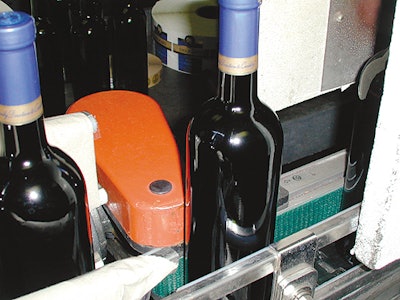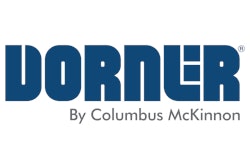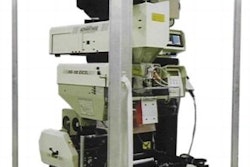Delicato Family Vineyards, Napa, CA, has worked for 75 years to gain the recognition of producing world-class wines. However, its bottling operation wasn’t up to the task of putting the fine wines in a world-class package, one that the owners could be proud to show.
That’s because the sole packaging line at the winery had difficulty bottling the wines without creating wrinkles in the bottles’ capsules. According to Rick Enos, project engineer at Delicato, as many as one in five bottles displayed unacceptable wrinkles.
“The marketing people select the capsule designs solely for their appearance, not for how they perform on the packaging line,” he says. The company typically uses stock capsules, often with different colors. As Enos has discovered, a simple heat tunnel for shrinking the capsules around the bottles’ necks can itself create a bottleneck when the capsules combine colors that are both heat reflective and heat absorbing.
“Many of our capsules have a couple of gold bands near the bottom,” he says. “The gold color reflects the heat of the heat tunnel, while the dark color of the rest of the capsule is absorbing the heat. This can cause wrinkling because you have the difference in heat-absorption and -reflectance.”
The key, says Enos, is rotating the bottles sufficiently as they are conveyed through the heat tunnel. “When you have the combination of reflectance and absorption, you end up with different shrinkage rates within the same capsule. But if your line can rotate the bottle a few times, you can even it out.”
All capsules used by Delicato are made of polyvinyl chloride, but the metallic color bands that make the capsules more attractive weren’t making the heat-shrunk capsules as attractive as they should have been.
Chance call spells success
As so often happens in problem solving these days, the solution to the Delicato problem came as the result of a sales cold call. Enos relates, “You’ve got to remember that most of the bottles with wrinkled capsules were never even noticed by the consumer, so we didn’t really have a policy about repackaging them.”
Still, Pete Hayward, a sales representative for distributor Sierra Conveyor (Rocklin, CA), happened to make a cold sales call on Enos. “Since he knew conveyors, I challenged him to come up with a solution to make the bottles spin sideways in the heat tunnel,” Enos says. “This was just totally off the cuff. So he came up with the idea of using a stock belted conveyor, turned on its side. If he hadn’t stopped in that day, who knows what we might have come up with? In this case, it was just a matter of him being in the right place at the right time, and us asking the right question at the right time.”
Hayward’s solution was to install a low-profile, five-foot 2200 Series belt conveyor made by Dorner Mfg. Co. (Hartland, WI)—but on its side. When it operates at the correct speed and pressure against the bottle and fixed-position guiderail, it spins the wine bottles six to seven times while they travel through the heat tunnel.
But not so simple
Although this represents what Enos calls a “low-tech way for us to achieve a better-quality package,” there’s a bit more to it than simply mounting a conveyor belt vertically instead of horizontally.
The big issue, he says, is getting the right pressure on a variety of bottle sizes. The winery produces wines in both 750-mL and 1.5-L bottles. But in just the 750-mL size, there are three different bottle diameters, so settings for the conveyor represent a challenge for the line’s mechanics.
The 1¾”-wide conveyor belt is narrow enough so that it stays down low on the bottle and away from the heat above. But wine bottles aren’t perfectly straight-sided, so vertical placement of the belt was an issue. This challenge, Enos says, was met with a good stand that Delicato crafted that doesn’t require adjusting the conveyor vertically, no matter what size bottle is being run.
“On the conveyor, we installed a variable-frequency drive, so the belt speed isn’t a problem any more,” Enos says. “However, we’re still working on the horizontal positions, getting the right pressure for the right bottle diameter.”
Belt doesn’t move vertically
In Delicato’s line, the conveyor’s high-friction belt surface grips the bottle against the guiderail causing it to spin as the bottle is conveyed through the heat tunnel. “The belt is traveling at a higher speed than the bottle, and spinning the bottle helps even out the heat distribution to the capsule that’s being shrunk.”
The side conveyor uses a V-guided belt, which means the belt can’t slide down, even though it operates vertically instead of horizontally. A urethane V-shaped guide is applied to the back of the belt, so it rides in a V-shaped groove formed in the conveyor frame.
The new conveyor has been in operation for about a year, Enos says, and the winery has had to replace the belt just once. “We ordered a spare, so we always have one spare, just in case. After all, this is a wear part, so you know you have to be ready to replace the belt.”
In the winery’s single packaging line, bottles are filled and corked, and capsules are hand-applied and heat shrunk—all before bottles are labeled. “Because the labels are so expensive, it’s the last step in the operation,” Enos says. “After all, the last thing you want to do is apply costly pressure-sensitive labels to bottles that might be rejected for some other reason.”
As helpful as the new conveyor has been, Delicato is now about to add a new capsule applicator to replace hand-application. Hand-application of capsules is not the easiest of packaging jobs, Enos says, and the plant had to rotate people in and out of that operation frequently. Later this year, Delicato plans to add a new filler that will enable the line to operate faster than 100 bpm.
This family-owned winery is continuing to see improved sales, so its bottling line needs to improve output. However, Enos says, Delicato’s wine packaging represents only a part of its business, the balance being its vineyards and processing grapes for other wineries.





























